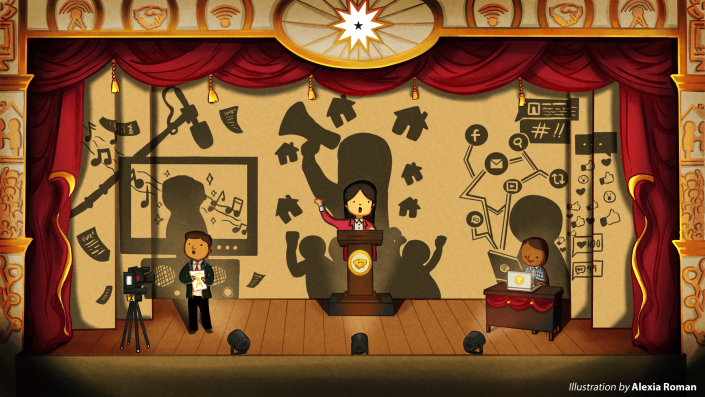The counts will not be official until at least the end of May, but it is already clear that Ferdinand “Bongbong” Marcos Jr. is on his way to Malacañang. The son and namesake of the late dictator is leading with a landslide figure of over 31 million votes, double of second placer Vice President Leni Robredo’s 15 million.
Not even incumbent President Rodrigo Duterte had that much support when he swept the 2016 elections with 16 million votes. But the victories of both Duterte and Marcos Jr. have a common facet—they both won the “war” on social media. While most of what is known in electoral politics remains textbook, Duterte’s online campaign was seen as a prototype for the novel social media machinery that strengthened a Marcos back into power.

Social media—the ‘hip’ new place for campaigning
After the COVID-19 pandemic forced the world into lockdown, social media use in the Philippines soared dramatically to levels that some experts have even called “problematic”. It has then become ripe ground for a wide range of audiences when looking to get a word out.
Francis Dee, former assistant professor of the Department of Political Science at the University of the Philippines, says electoral campaigns in the Philippines have recently spread out to three “theaters of war”.
“You have the air war, which is broadcast media,” says Dee ahead of the crucial May 9 voting. “You have the ground war, which is actual physical campaigning, and then you have the online war, which is this new thing that’s been around since, technically, 2010, but only started really becoming super impactful in this last election of 2016.”
Broadcast media used to be the main campaign strategy for candidates, accompanied by on-ground efforts, says Gerardo Eusebio, professorial lecturer at the Department of Political Science. “But now, media is divided between social media and the mainstream media,” he adds. Most of these “mainstream media”—which includes traditional platforms like newspapers, television, and radio—have been out of vogue and replaced by the convenience of the internet.
Assemblies and house-to-house campaigns, some common practices of ground campaigning, can only do so much for national candidates, according to Eusebio. “If you really just rely on it for its value, like how you go to the small streets and knock on every door, kaunti lang ang makukuha mong boto roon,” he says.
(That will only get you a meager amount of votes.)
“However, if you project house-to-house campaigning through social media, national candidates can tap more voters,” Eusebio adds.
On-ground campaign is king…supposedly
Dee, meanwhile, is skeptical about the magnitude of online platforms’ influence in this year’s elections. “I’m sort of settled on the position that…its importance was a bit overblown in 2016,” he says, referring to Duterte’s presidential win, which is popularly thought to have been bolstered by social media.
“While it was President Duterte making a big splash online during the campaign period [that] definitely led him to winning, that had to pass through several steps of traditional campaigning.”
Department of Political Science Associate Professor Dr. Cleo Anne Calimbahin stresses the importance of physical campaigning, especially in local politics. “Given the nature of Filipino voters, social media, for now, does not diminish the need for face-to-face [or] on-the-ground campaigns,” she says.
Although all three theaters of war are relevant, Calimbahin highlights that it is the ground war that most effectively convinces voters. Aside from electoral support, national-level politicians also seek the support of local candidates as a means to amplify their presence to voters in various districts.
Eusebio, a campaign strategist, echoes this sentiment, saying the ground war and the air war are crucial to getting voters that the internet cannot reach. It also allows the candidate to have intimacy with voters, he says, adding that it is “very effective because it brings that candidate to the hearts of the people.”
Fighting the online war ahead of everyone
While many political experts swear by the importance of on-ground campaigning, Marcos did not have to be the best in it to secure a landslide victory.
“They seem to be doing very different things,” Dee comments on the social media strategies of Marcos and Robredo.
In a February report, the Philippine Center for Investigative Journalism found that Robredo topped all candidates on Facebook ad spending with P14.1 million spent since August 2020. But this helped put her only in second place on surveys, far behind Marcos who has not recorded any ad spending as per the report.
“They seem to know where to allocate their money, where there’s more bang for their buck than where other candidates—Vice President Robredo included—are spending,” Dee says of the Marcos campaign. To other analysts, it appears Marcos’ team found “more bang for their buck” with a years-long disinformation campaign on the internet built on pro-Marcos propaganda.
With educators warning that this period in history was not thoroughly taught in schools, people became vulnerable to being exploited by videos on Facebook, TikTok, and YouTube that painted the older Marcos’ regime as a “golden era” of prosperity and security.
Combine this with decades of frustration over the failures of previous administrations—a soft spot that Duterte had used to make himself a loved populist—and an internet-propelled nostalgia for the Marcos Sr. period can make people happy to elect Marcos Jr. for a change.
EDITOR’S NOTE: May 20, 2021
The original version of this article was published with a typographical error in Dr. Calimbahin’s name. The publication apologizes for this error.
